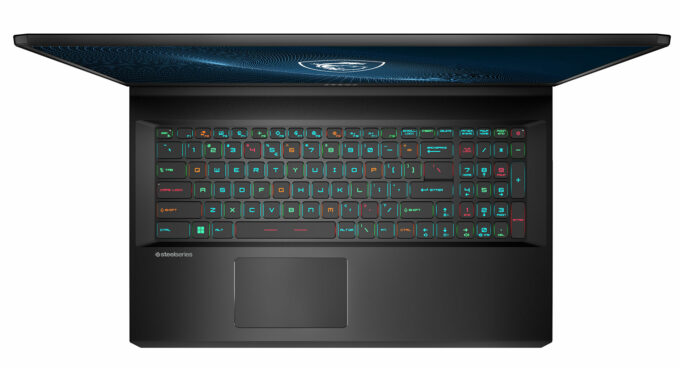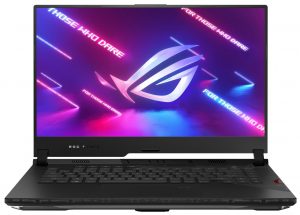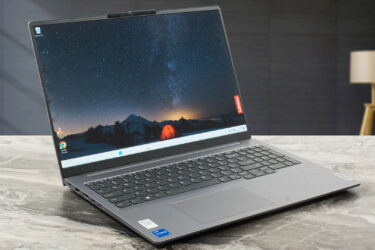[In-Depth Comparison] MSI Vector GP66 vs ASUS ROG Strix SCAR 15 G533 – a proper Main Event
 Today we have a real main event between two heavyweights, which bring the best available flagship hardware from all three manufacturers.
Today we have a real main event between two heavyweights, which bring the best available flagship hardware from all three manufacturers.
The MSI Vector GP66 is transformed from its former Leopard name, which brings powerful new components to the table, making it one of the most powerful laptops that you can get right now. With a design to match a supercar, and the powertrain under the hood to back it up, only financial reasons might stop you from pulling the trigger on one of these.
Going against it is ASUS’s ultimate gaming weapon, the ROG Strix SCAR 15 G533, which is as high as ASUS goes in their gaming portfolio. There is a clear hardware advantage for the Vector GP66, as its Alder Lake H-series processors go against the now year-old Ryzen 5000 H-series CPUs. Since there hasn’t been a significant shake-up in the GPU space, both laptops enjoy the company of the RTX Ampere 3000-series GPUs.
Today we are presenting you with an in-depth comparison between the MSI Vector GP66 (12Ux) and the ASUS ROG Strix SCAR 15 G533.
MSI Vector GP66 (12Ux): Full Specs / In-depth Review
ASUS ROG Strix SCAR 15 G533: Full Specs / In-depth Review
MSI Vector GP66 (12Ux) configurations:
ASUS ROG Strix SCAR 15 G533 configurations:
Contents
Design and construction
The Vector laptop is entirely made out of aluminum, resulting in a sleek device that is easy on the eyes with its black exterior and no RGB. The notebook is bulky, weighing 2.38 kg and having a profile of 23.4 mm. There are some aggressive features, mainly the bulging hinge covers, which have been a staple in MSI’s design language, appearing on other devices as well. This gives the machine a look that is reminiscent of a sports car, with a sleek and aerodynamic front to punch through the air and a bulging rear that people fear from a distance.
The ROG laptop is very different, built from the ground up to be an eye-catcher. Enveloped in RGB, it has a strip below the bottom panel, and a light-up logo on the back of the lid, which results in quite the light show when tuned together. The design is much more uniform and rectangular, with the RGB doing most of the talking. Part of the base is also transparent, allowing you to peek into the insides of the device. The notebook is slightly lighter, weighing 2.30 kg and having a thicker profile that goes up to 27.2 mm at the rear.
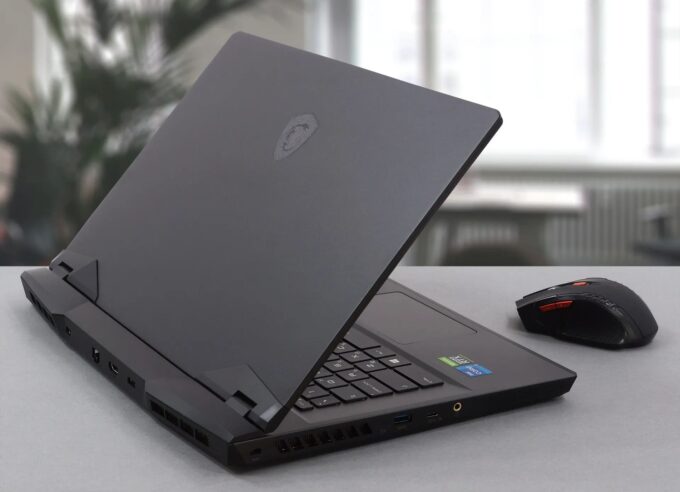 MSI Vector GP66 (12Ux)
MSI Vector GP66 (12Ux)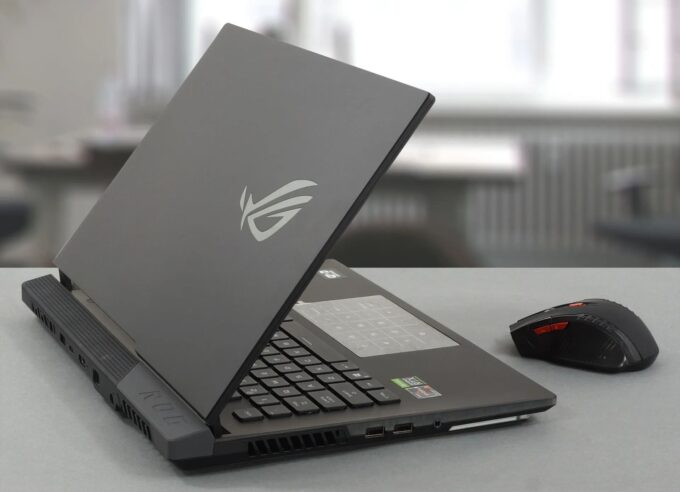 ASUS ROG Strix SCAR 15 G533
ASUS ROG Strix SCAR 15 G533Keyboard and touchpad
Both laptops have decided to go all-in on the gaming part, as they should, eliminating the traditional NumPad from their keyboard, in favor of larger keycaps and more space between them. On the Vector laptop, the keyboard is provided by Steelseries, which has been a partnership that has stood the test of time. It’s a good strategy to partner up with an established company in order to make the laptop a more appealing option. The unit has a per-key RGB backlight, and while the key travel is a tad shallow, the feedback is plenty clicky. The touchpad suffers from the same shorter travel and the small size doesn’t help either. However, the tracking on it is really good.
Going over to the ASUS unit, it goes about it in an entirely different manner. ASUS uses optical-mechanical switches, which use light to detect input, making lowering the latency down to 0.2 ms, while offering a log 1.9 mm key travel. The switches offer a satisfying click and are very comfortable to use. However, the resistance is very little, so pressing them is very easy. The NumPad on the notebook is integrated into the touchpad, being able to be used whenever needed. This also makes the pad large enough to allow for comfortable use.
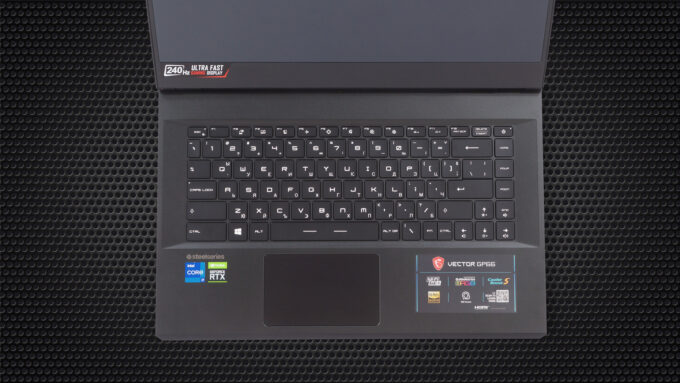 MSI Vector GP66 (12Ux)
MSI Vector GP66 (12Ux)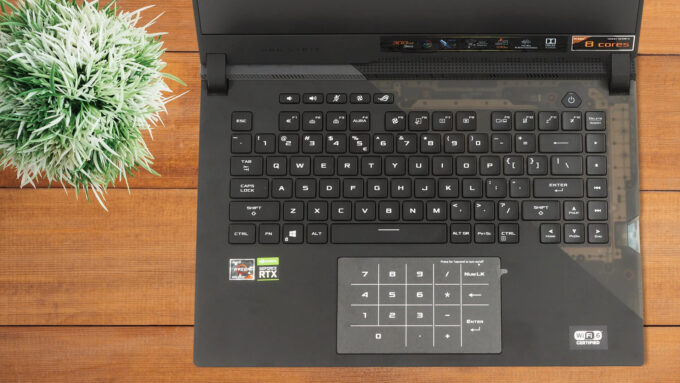 ASUS ROG Strix SCAR 15 G533
ASUS ROG Strix SCAR 15 G533Ports
The MSI laptop comes with three USB Type-A 3.2 (Gen. 1) ports, a USB Type-C 3.2 (Gen. 2) port, an HDMI connector, a 3.5 mm audio jack, a LAN port, and a Mini DisplayPort.
As for the ROG device, It brings much of the same, including the same number of USB Type-A and Type-C ports, along with an HDMI 2.1b port, a LAN port, and a 3.5 mm audio jack, lacking a separate DisplayPort.
MSI Vector GP66 (12Ux)



ASUS ROG Strix SCAR 15 G533 (2022)



Spec sheet comparison
MSI Vector GP66 (12Ux) series
- Dimensions
- 358 x 267 x 23.4 mm (14.09" x 10.51" x 0.92")
- Weight
- 2.38 kg (5.2 lbs)
- Price
- Starting at $1713.99
ASUS ROG Strix SCAR 15 G533 series
- Dimensions
- 355 x 260 x 22.6 ~ 27.2 mm (13.98" x 10.24" x 0.89")
- Weight
- 2.30 kg (5.1 lbs)
- Price
- Starting at $1519.99
Disassembly, Upgrade options
Both laptops offer a lot of upgradeability. To take them apart, you have to undo 11 Phillips-head screws, after which you pry away the bottom panel with a plastic tool. After that, you can see that both of them have two SODIMM RAM slots and two M.2 PCIe x4 drive slots. Since the MSI device has an Alder Lake processor, it comes with DDR5 RAM that runs in dual-channel mode.
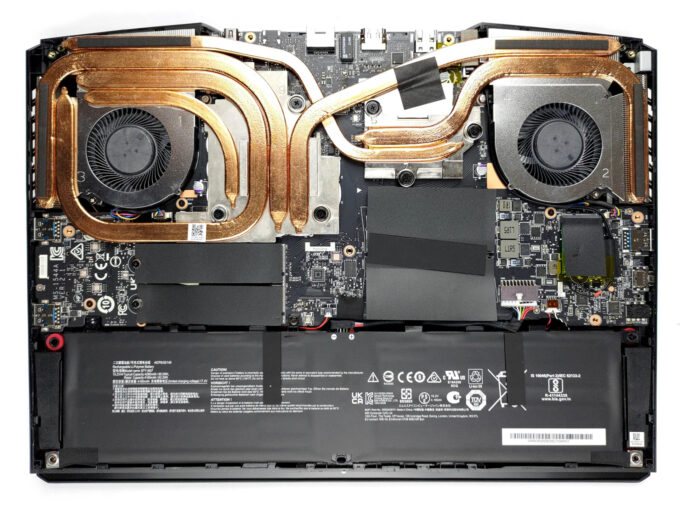 MSI Vector GP66 (12Ux)
MSI Vector GP66 (12Ux) ASUS ROG Strix SCAR 15 G533
ASUS ROG Strix SCAR 15 G533Display quality
The Vector offers three display choices, with either an FHD 360Hz display, a QHD 165Hz display, or a QHD 240Hz. On the side of the ASUS, you can get either an FHD 300Hz panel or a QHD 165Hz panel. We tested the QHD 165Hz panel on the MSI device and the FHD panel on the ASUS device. Obviously, the higher resolution panel comes with a higher pixel density, a lower pitch, and a lower Retina distance of 188 PPI, 0.13 x 0.13 mm, and 46 cm, respectively.
 MSI Vector GP66 (12Ux)
MSI Vector GP66 (12Ux)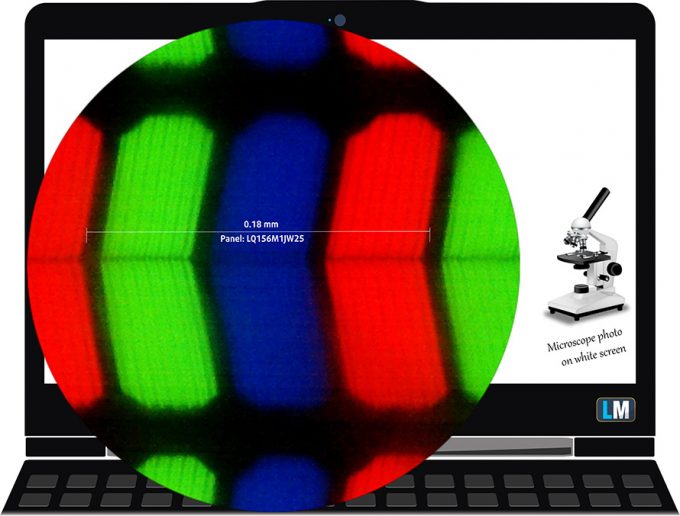 ASUS ROG Strix SCAR 15 G533
ASUS ROG Strix SCAR 15 G533Both laptops offer excellent viewing angles. We offer images at 45° to evaluate image quality.
 MSI Vector GP66 (12Ux)
MSI Vector GP66 (12Ux) ASUS ROG Strix SCAR 15 G533
ASUS ROG Strix SCAR 15 G533The panel of the MSI device has a max brightness of 343 nits in the middle of the screen and 326 nits as an average for the whole area, with a maximum deviation of 5%. The contrast ratio is decent at 1020:1.
The max brightness of the Strix SCAR 15 has a bit lower brightness of 328 nits in the middle of the screen and 307 nits as an average for the whole area, with a maximum deviation of 13%. The contrast ratio is a bit lower as well at 1000:1.
Ultimately, both laptops perform well in terms of uniformity, delivering even brightness across the entire display area.
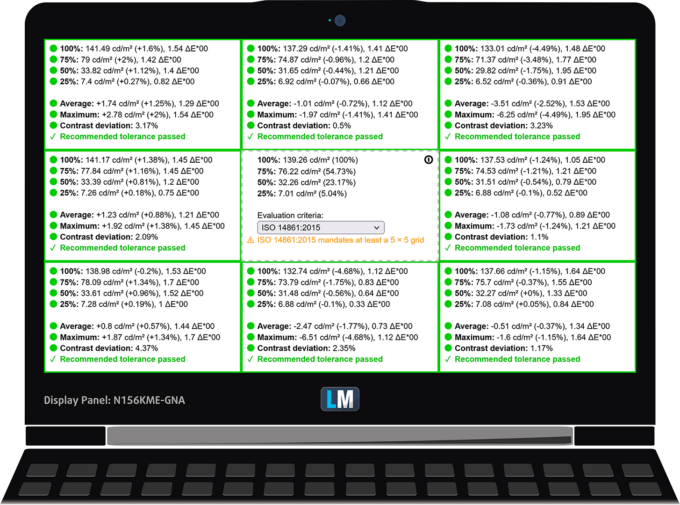 MSI Vector GP66 (12Ux)
MSI Vector GP66 (12Ux)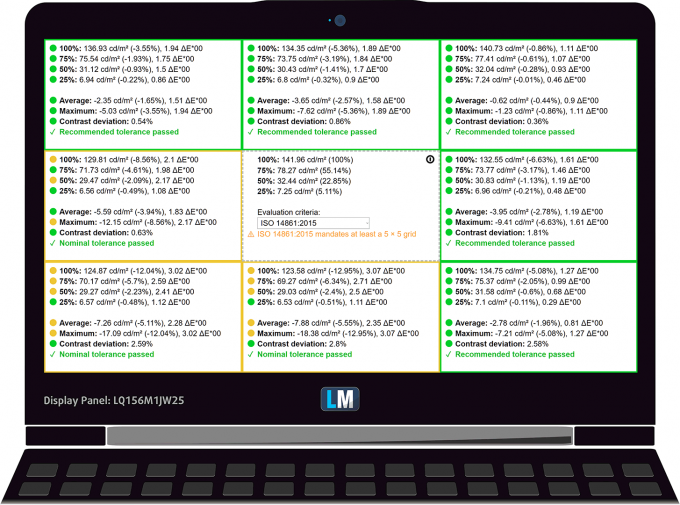 ASUS ROG Strix SCAR 15 G533
ASUS ROG Strix SCAR 15 G533Color coverage
To make sure we are on the same page, we would like to give you a little introduction to the sRGB color gamut and the Adobe RGB. To start, there’s the CIE 1976 Uniform Chromaticity Diagram that represents the visible specter of colors by the human eye, giving you a better perception of the color gamut coverage and the color accuracy.
Inside the black triangle, you will see the standard color gamut (sRGB) that is being used by millions of people on HDTV and on the web. As for the Adobe RGB, this is used in professional cameras, monitors, etc for printing. Basically, colors inside the black triangle are used by everyone and this is the essential part of the color quality and color accuracy of a mainstream notebook.
Still, we’ve included other color spaces like the famous DCI-P3 standard used by movie studios, as well as the digital UHD Rec.2020 standard. Rec.2020, however, is still a thing of the future and it’s difficult for today’s displays to cover that well. We’ve also included the so-called Michael Pointer gamut, or Pointer’s gamut, which represents the colors that naturally occur around us every day.
The yellow dotted line shows the color coverage of both the MSI Vector GP66 (12Ux) and the ASUS ROG Strix SCAR 15 G533 (2022).
The panel of the Vector fully covers the sRGB color gamut, along with 99% of the DCI-P3 gamut. The ASUS panel covers 97% of the sRGB gamut.
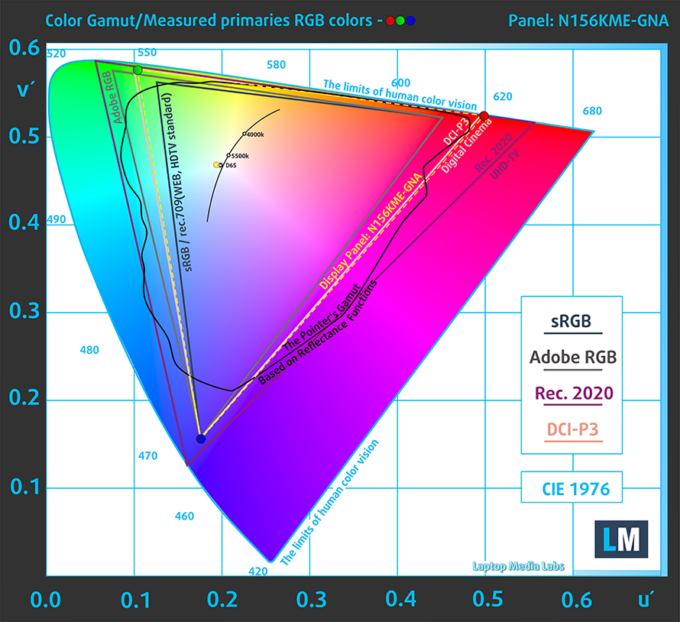 MSI Vector GP66 (12Ux)
MSI Vector GP66 (12Ux)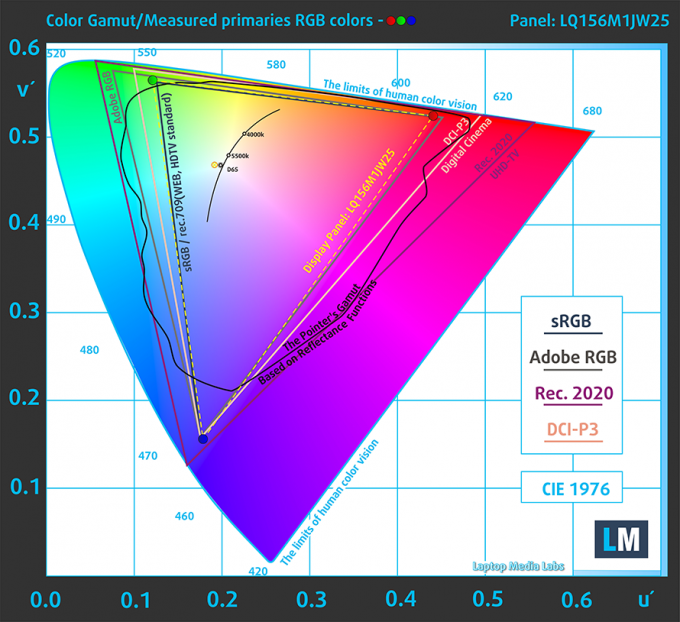 ASUS ROG Strix SCAR 15 G533
ASUS ROG Strix SCAR 15 G533Color accuracy
We tested the accuracy of the display with 24 commonly used colors like light and dark human skin, blue sky, green grass, orange, etc. You can check out the results in factory condition and also, with the “Design and Gaming” profile.
Below you can check the results from the test of both laptops, with both the factory settings (left) and with our “Design and Gaming” profile applied (right).
The Vector reached its best results with a D65 white point in the DCI-P3 color space, lowering the dE value down to 0.8.
As for the Strix SCAR 15, just applying our profile lowers the dE value down to 0.6.
MSI Vector GP66 (12Ux)
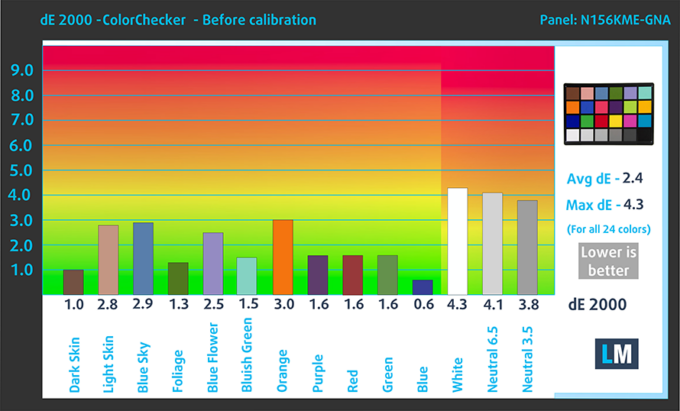
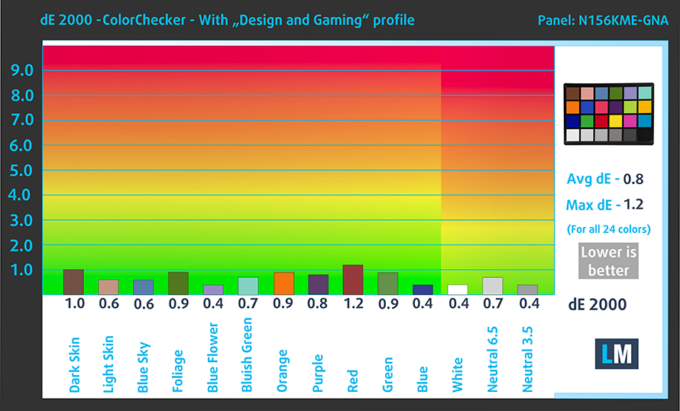
ASUS ROG Strix SCAR 15 G533 (2022)
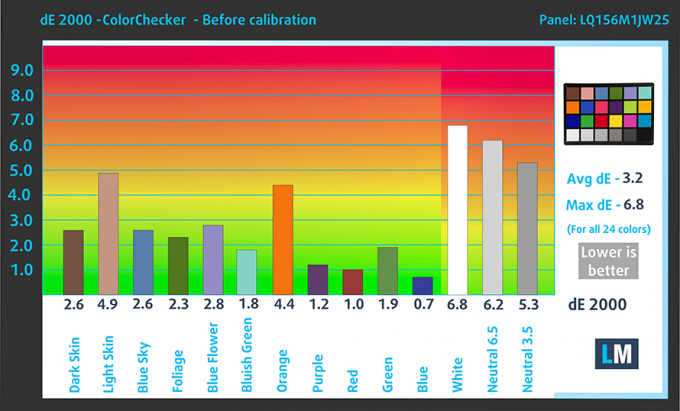
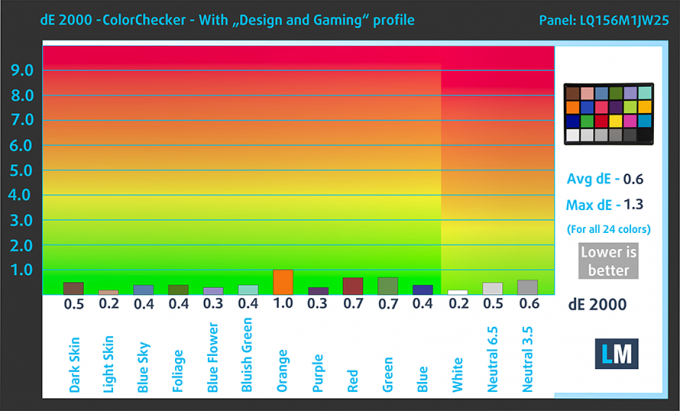
Response time (Gaming capabilities)
We test the reaction time of the pixels with the usual “black-to-white” and “white-to-black” method from 10% to 90% and vice versa.
Both laptops come with seriously fast displays, but the ROG Strix SCAR 15 G533 takes the cake with a Fall + Rise time of 9.1 ms.
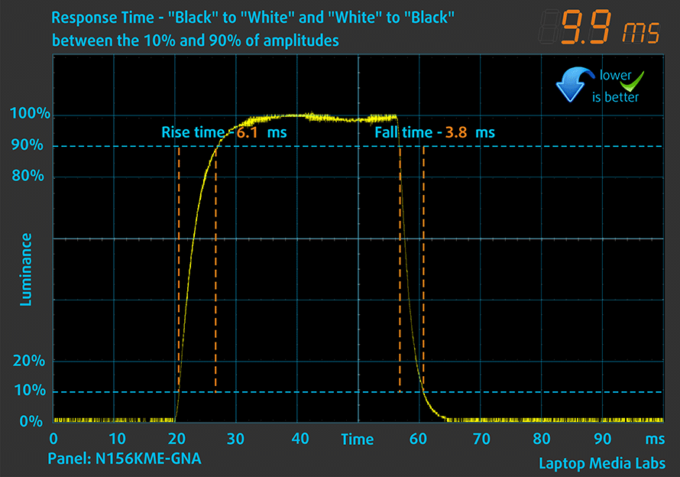 MSI Vector GP66 (12Ux)
MSI Vector GP66 (12Ux)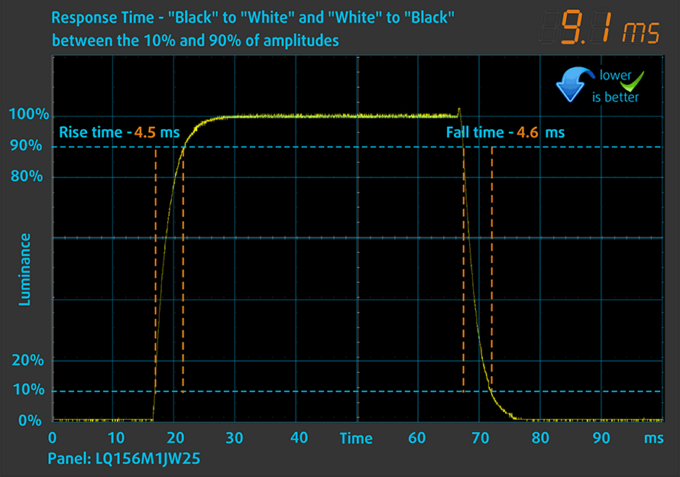 ASUS ROG Strix SCAR 15 G533
ASUS ROG Strix SCAR 15 G533Health Impact / PWM (Blue light)
PWM – Screen flickering
Pulse-width modulation (PWM) is an easy way to control monitor brightness. When you lower the brightness, the light intensity of the backlight is not lowered, but instead turned off and on by the electronics with a frequency indistinguishable by the human eye. In these light impulses, the light/no-light time ratio varies, while brightness remains unchanged, which is harmful to your eyes. You can read more about that in our dedicated article on PWM.
Both laptops use no PWM across all brightness levels, meaning that the displays are comfortable to use, without presenting any excessive eye strain in this aspect.
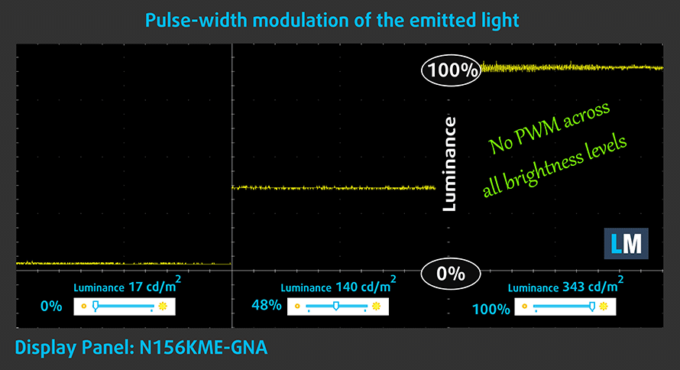 MSI Vector GP66 (12Ux)
MSI Vector GP66 (12Ux) ASUS ROG Strix SCAR 15 G533
ASUS ROG Strix SCAR 15 G533Blue light emissions
Installing our Health-Guard profile not only eliminates PWM but also reduces the harmful Blue Light emissions while keeping the colors of the screen perceptually accurate. If you’re not familiar with the Blue light, the TL;DR version is – emissions that negatively affect your eyes, skin, and your whole body. You can find more information about that in our dedicated article on Blue Light.
Buy our profiles
MSI Vector GP66 (12Ux) 15.6″ QHD IPS Innolux N156KME-GNA (CMN152A): Buy our profiles
ASUS ROG Strix SCAR 15 G533 15.6″ FHD IPS Sharp LQ156M1JW25 (SHP152C): Buy our profiles
Sound
The MSI laptop has two speakers on the bottom, firing from the left and right sides of the device. On the SCAR 15, we see two 2W front-firing units and two 4W units that are on the bottom, which makes for a pretty loud quad-stereo setup with no deviations across the entire frequency range. As for the MSI device, its setup offers good audio, but there are deviations in the lows, mids, and highs.
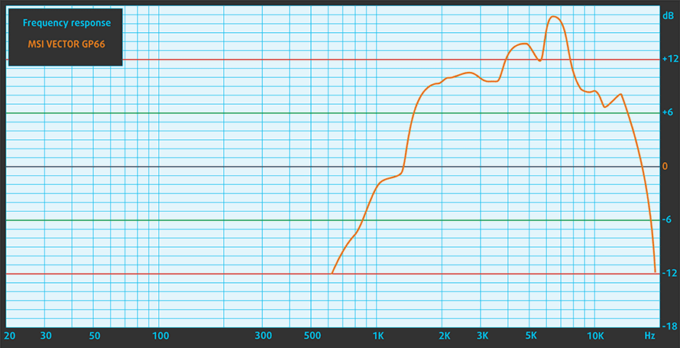 MSI Vector GP66 (12Ux)
MSI Vector GP66 (12Ux)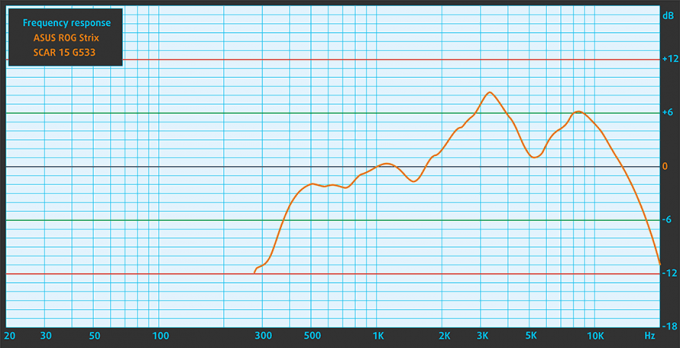 ASUS ROG Strix SCAR 15 G533
ASUS ROG Strix SCAR 15 G533Battery life
The MSI laptop comes with a 65Wh unit, which is unusual for a beefy gaming laptop and it shows its failures in the battery tests. As for the ASUS, it brings a big 90Wh battery pack, which allows it to last for 15 hours and 4 minutes of Web browsing and 10 hours and 45 minutes of video playback, unheard numbers from a gaming device. This is around 9 hours more in web browsing and nearly 6 hours more in video playback.
In order to simulate real-life conditions, we used our own script for automatic web browsing through over 70 websites.


For every test like this, we use the same video in HD.


Performance
The MSI device here comes in with a pretty big advantage in the form of the Alder Lake H-series processors. The high core and thread count make for some significant performance increases, which you can see down below. The ASUS laptop uses the Ryzen 5000H-series CPUs, which was great at the time when we reviewed the device around the same time last year. In terms of graphics, both devices use the RTX Ampere 30-series but the Vector has the advantage of being a newer device, offering the RTX 3070 Ti and RTX 3080 Ti.
CPU benchmarks
Here we tested the Intel Core i7-12700H and the AMD Ryzen 7 5800H. The Intel processor comes ahead by a large margin, scoring 41% higher in 3D Rendering in Cinebench 20 and being nearly two seconds quicker in the Photoshop benchmark.
Results are from the Cinebench R23 CPU test (the higher the score, the better)
Results are from our Photoshop benchmark test (the lower the score, the better)
GPU benchmarks
Here we tested the RTX 3080 inside both laptops, however, the MSI model brings a more powerful 150W version, a whole 20W lead which comes in clutch. The GPU inside the Vector notebook scores 10% higher in 3DMark Fire Strike and 7% higher in Unigine Superposition.
Results are from the 3DMark: Time Spy (Graphics) benchmark (higher the score, the better)
Results are from the 3DMark: Fire Strike (Graphics) benchmark (higher the score, the better)
Results are from the Unigine Superposition benchmark (higher the score, the better)
Gaming tests
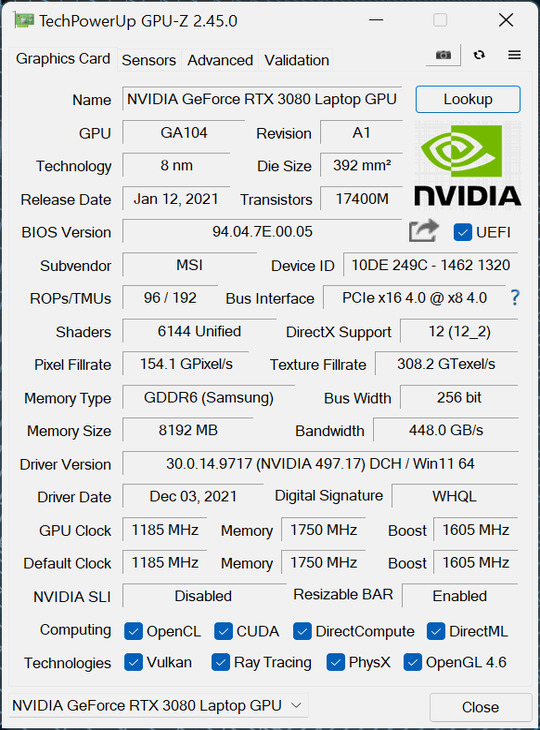 MSI Vector GP66 (12Ux)
MSI Vector GP66 (12Ux)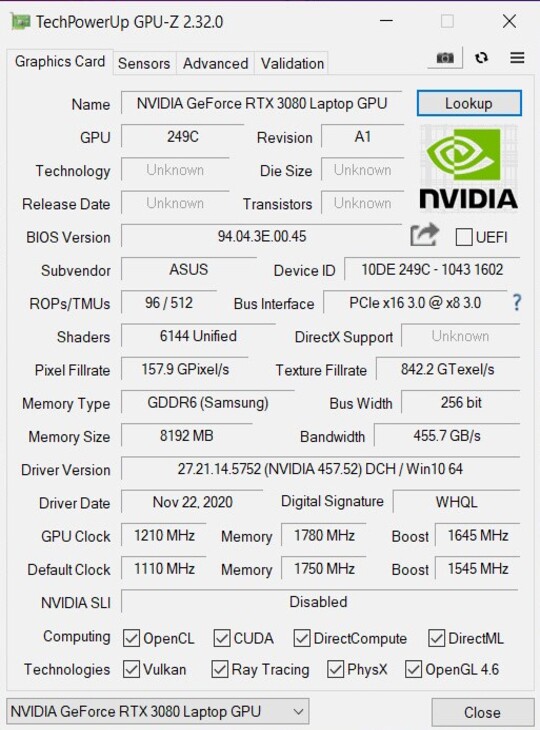 ASUS ROG Strix SCAR 15 G533
ASUS ROG Strix SCAR 15 G533
| Tom Clancy’s Ghost Recon Wildlands | Full HD, High (Check settings) | Full HD, Very High (Check settings) | Full HD, Ultra (Check settings) |
|---|---|---|---|
| MSI Vector GP66 – GeForce RTX 3080 (150W) | 134 fps (+34%) | 118 fps (+34%) | 80 fps (+18%) |
| ASUS ROG Strix SCAR 15 G533 – GeForce RTX 3080 (130W) | 100 fps | 89 fps | 68 fps |

| Shadow of the Tomb Raider (2018) | Full HD, Medium (Check settings) | Full HD, High (Check settings) | Full HD, Highest (Check settings) |
|---|---|---|---|
| MSI Vector GP66 – GeForce RTX 3080 (150W) | 126 fps (+18%) | 122 fps (+15%) | 104 fps (+14%) |
| ASUS ROG Strix SCAR 15 G533 – GeForce RTX 3080 (130W) | 107 fps | 106 fps | 91 fps |
Temperatures and comfort
We don’t see copper that often in modern laptops, so we appreciate MSI and their six copper heat pipes that shine bright. Two of them are for the CPU, the three bigger ones are left for the GPU, while the last one keeps the VRMs and GPU memory in check.
As for the ASUS device, it also has six heat pipes, but the arrangement is a bit different. There is one bulky pipe for both the CPU and GPU, while there are two separate heat pipes for each of them. The last is for the VRMs and the graphics memory.
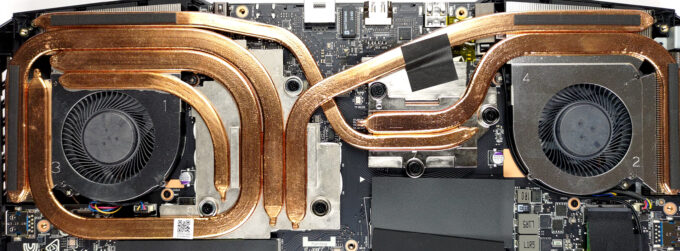 MSI Vector GP66 (12Ux)
MSI Vector GP66 (12Ux)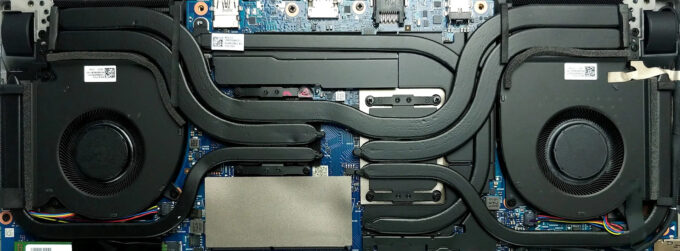 ASUS ROG Strix SCAR 15 G533
ASUS ROG Strix SCAR 15 G533Max CPU load
In this test we use 100% on the CPU cores, monitoring their frequencies and chip temperature. The first column shows a computer’s reaction to a short load (2-10 seconds), the second column simulates a serious task (between 15 and 30 seconds), and the third column is a good indicator of how good the laptop is for long loads such as video rendering.
Average core frequency (base frequency + X); CPU temp.
| Intel Core i7-12700H (45W TDP) | 0:02 – 0:10 sec | 0:15 – 0:30 sec | 10:00 – 15:00 min |
|---|---|---|---|
| MSI Vector GP66 (12Ux) | 3.81 GHz @ 2.91 GHz @ 81°C @ 116W | 3.54 GHz @ 2.72 GHz @ 83°C @ 98W | 3.30 GHz @ 2.57 GHz @ 79°C @ 86W |
The Vector keeps its Core i7-12700H running at good speeds for both its Performance and Efficiency cores. The temperatures maintained low and relatively even during the entirety of our test.
| AMD Ryzen 7 5800H (45W TDP) | 0:02 – 0:10 sec | 0:15 – 0:30 sec | 10:00 – 15:00 min |
|---|---|---|---|
| ASUS ROG Strix SCAR 15 G533 | 3.43 GHz (B+7%) @ 76°C | 3.35 GHz (B+5%) @ 80°C | 3.47 GHz (B+8%) @ 82°C |
The Ryzen 7 5800H inside ran at similar temperatures, while its clock speeds remained even during all three stages of the test.
Real-life gaming
| NVIDIA GeForce RTX 3080 | GPU frequency/ Core temp (after 2 min) | GPU frequency/ Core temp (after 30 min) | GPU frequency/ Core temp (Max Fans) |
|---|---|---|---|
| MSI Vector GP66 (12Ux) | 1690 MHz @ 76°C @ 149W | 1671 MHz @ 81°C @ 149W | 1698 MHz @ 75°C @ 149W |
| ASUS ROG Srix SCAR 15 G533 | 1616 MHz @ 80°C @ 130W | 1597 MHz @ 82°C @ 130W | – |
With a higher TGP and more room to play with, the GPU runs cooler and at higher speeds.
Comfort during full load
Both laptops don’t get uncomfortably hot on the outside, but the MSI Vector is still cooler, running at a 3°C lower temperature.
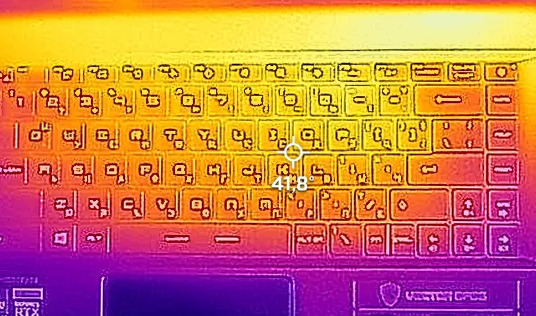 MSI Vector GP66 (12Ux)
MSI Vector GP66 (12Ux)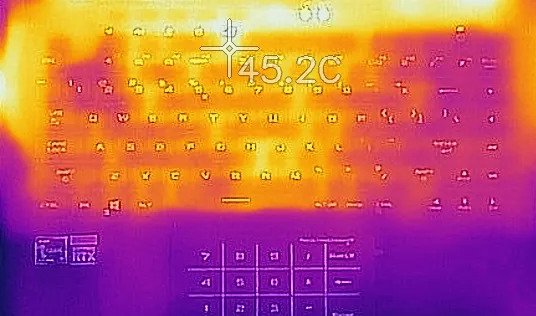 ASUS ROG Strix SCAR 15 G533
ASUS ROG Strix SCAR 15 G533Verdict
Both laptops present a flagship gaming and Creator experience, and will totally be able to satisfy anyone’s gaming needs unless you’re crazy and play at 8K or you’re just an “Anonymous” hacker. That said when directly comparing them, there are obvious performance advantages for the MSI Vector, due to it being much newer, releasing not hat long ago. In contrast, the ASUS ROG Strix SCAR 15 we reviewed a year ago, so it’s completely understandable, but we needed a good baseline to compare the Vector to and the ROG laptop did its job perfectly.
In terms of the design, both of them come with durable bodies that will keep the inside shielded and protected. The Vector has a better-looking chassis in our opinion, but there is a big crowd for the RGB-infused ASUS laptops as well. ASUS also totally killed it with its input devices, delivering optical-mechanical switches with long key travel and clicky feedback, along with a large touchpad that has an integrated NumPad, so in reality, you’re not really losing much. ASUS also fixed its small Arrow keys problem.
We like the Vector’s I/O, being able to connect up to three external monitors. Both laptops are even in terms of upgradeability, offering two RAM slots and two SSD slots. Both laptops also bring very fast displays with high refresh rates and great color coverage and accuracy, being able to be used for Creator tasks.
The ASUS device brings quad-stereo speakers, delivering loud sound with great quality. Its battery also lasts for a lot longer with leads of 9 hours in web browsing and 6 hours in video playback. While it lacks battery life, the MSI Vector delivers on the performance, with its Core i7-12700H and RTX 3080 outperforming their counterparts.
Both laptops come with very good cooling setups, which ensure a smooth operation on the inside, with no component overheating during all stages of our stress tests.
The lack of a larger battery really is an Achilles heel for the Vector, being one of the few things which might be off-putting to consumers.
Why choose the MSI Vector GP66 (12Ux)?
- + More performance
- + Access to the RTX 3080 Ti and RTX 3070 Ti
- + Wider I/O
Why choose the ASUS ROG Strix SCAR 15 G533?
- + Longer battery life
- + Better keyboard
- + Has a NumPad
MSI Vector GP66 (12Ux): Full Specs / In-depth Review
ASUS ROG Strix SCAR 15 G533: Full Specs / In-depth Review
